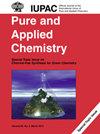Production of oil palm mesocarp fiber-based hydrogel using selected cross-linking acids
IF 2
4区 化学
Q3 CHEMISTRY, MULTIDISCIPLINARY
引用次数: 0
Abstract
Over the years, studies showed that hydrogels can be produced through synthetic route to overcome the limitations in obtaining natural-based hydrogels. Biomass resources offer potential alternatives as renewable feedstocks due to their outstanding biodegradability and biocompatibility. Oil palm mesocarp fiber (MF) is the biomass residue obtained after the pressing of palm fruits during palm oil extraction. There is approximately 11 % MF generated from palm fruits after oil extraction. However, the applications of MF are limited. This study aimed to investigate the development of hydrogels from holocellulose MF instead of commonly used cellulose which involving several pretreatment steps, through acid cross-linkers. Holocellulose MF was selected as polymer for chemical cross-linking with two inexpensive and nontoxic hydrophilic organic acids, citric acid and acetic acid for hydrogel production. Comparison study was carried out to evaluate the physicochemical properties, and degree of swelling, as well as gel content in different media for both acids in the production of hydrogel from holocellulose MF. Results indicated that the optimum concentrations of citric acid and acetic acid for gel content and degree of swelling were 5 M and 2 M, respectively. Both optimized hydrogels exhibited comparable profiles in terms of morphology, thermal stability and functional groups, in addition to showing similar degree of swelling profile in different media, i.e., salt solution, acidic, neutral to alkaline, implying their distinctive characteristics. In summary, holocellulose MF is suitable for the production of hydrogel with citric acid and acetic acid as crosslinkers for different desired applications.利用选定的交联酸生产油棕中果皮纤维水凝胶
多年来的研究表明,可以通过合成途径生产水凝胶,以克服天然水凝胶的局限性。生物质资源因其出色的生物降解性和生物相容性,为可再生原料提供了潜在的替代品。油棕中果皮纤维(MF)是在棕榈榨油过程中压榨棕榈果实后获得的生物质残渣。棕榈果榨油后产生的中果皮纤维约占 11%。然而,MF 的应用非常有限。本研究旨在通过酸交联剂,研究用全纤维素 MF 替代常用的纤维素开发水凝胶。全纤维素中链被选为与两种廉价无毒的亲水性有机酸(柠檬酸和醋酸)进行化学交联的聚合物,用于生产水凝胶。在用全纤维素 MF 制备水凝胶的过程中,对两种酸在不同介质中的理化性质、溶胀程度和凝胶含量进行了比较研究。结果表明,柠檬酸和醋酸对凝胶含量和溶胀度的最佳浓度分别为 5 兆帕和 2 兆帕。两种优化的水凝胶在形态、热稳定性和官能团方面都表现出相似的特征,此外在不同介质(即盐溶液、酸性、中性至碱性)中也表现出相似的溶胀度,这意味着它们具有各自的特点。总之,全纤维素 MF 适用于以柠檬酸和醋酸为交联剂生产水凝胶,以满足不同的应用需求。
本文章由计算机程序翻译,如有差异,请以英文原文为准。
求助全文
约1分钟内获得全文
求助全文
来源期刊

Pure and Applied Chemistry
化学-化学综合
CiteScore
4.00
自引率
0.00%
发文量
60
审稿时长
3-8 weeks
期刊介绍:
Pure and Applied Chemistry is the official monthly Journal of IUPAC, with responsibility for publishing works arising from those international scientific events and projects that are sponsored and undertaken by the Union. The policy is to publish highly topical and credible works at the forefront of all aspects of pure and applied chemistry, and the attendant goal is to promote widespread acceptance of the Journal as an authoritative and indispensable holding in academic and institutional libraries.
 求助内容:
求助内容: 应助结果提醒方式:
应助结果提醒方式:


